Women have higher protein content of beta-oxidation enzymes in skeletal muscle than men
- PMID: 20700461
- PMCID: PMC2917369
- DOI: 10.1371/journal.pone.0012025
Women have higher protein content of beta-oxidation enzymes in skeletal muscle than men
Abstract
It is well recognized that compared with men, women have better ultra-endurance capacity, oxidize more fat during endurance exercise, and are more resistant to fat oxidation defects i.e. diet-induced insulin resistance. Several groups have shown that the mRNA and protein transcribed and translated from genes related to transport of fatty acids into the muscle are greater in women than men; however, the mechanism(s) for the observed sex differences in fat oxidation remains to be determined. Muscle biopsies from the vastus lateralis were obtained from moderately active men (N=12) and women (N=11) at rest to examine mRNA and protein content of genes involved in lipid oxidation. Our results show that women have significantly higher protein content for tri-functional protein alpha (TFPalpha), very long chain acyl-CoA dehydrogenase (VLCAD), and medium chain acyl-CoA dehydrogenase (MCAD) (P<0.05). There was no significant sex difference in the expression of short-chain hydroxyacyl-CoA dehydrogenase (SCHAD), or peroxisome proliferator activated receptor alpha (PPARalpha), or PPARgamma, genes potentially involved in the transcriptional regulation of lipid metabolism. In conclusion, women have more protein content of the major enzymes involved in long and medium chain fatty acid oxidation which could account for the observed differences in fat oxidation during exercise.
Conflict of interest statement
Figures
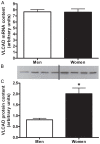
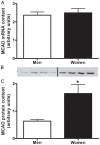
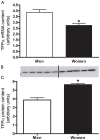
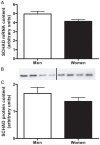
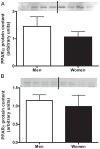
Similar articles
-
Men supplemented with 17beta-estradiol have increased beta-oxidation capacity in skeletal muscle.Physiol Genomics. 2010 Aug;42(3):342-7. doi: 10.1152/physiolgenomics.00016.2010. Epub 2010 May 18. Physiol Genomics. 2010. PMID: 20484157 Clinical Trial.
-
Different contribution of muscle and liver lipid metabolism to endurance capacity and obesity susceptibility of mice.J Appl Physiol (1985). 2009 Mar;106(3):871-9. doi: 10.1152/japplphysiol.90804.2008. Epub 2009 Jan 8. J Appl Physiol (1985). 2009. PMID: 19131482
-
Interactions between the consumption of a high-fat diet and fasting in the regulation of fatty acid oxidation enzyme gene expression: an evaluation of potential mechanisms.Am J Physiol Regul Integr Comp Physiol. 2011 Feb;300(2):R212-21. doi: 10.1152/ajpregu.00367.2010. Epub 2010 Nov 17. Am J Physiol Regul Integr Comp Physiol. 2011. PMID: 21084676
-
Regulation of energy metabolism by long-chain fatty acids.Prog Lipid Res. 2014 Jan;53:124-44. doi: 10.1016/j.plipres.2013.12.001. Epub 2013 Dec 18. Prog Lipid Res. 2014. PMID: 24362249 Review.
-
[PPARs Mediate the Regulation of Energy Metabolism By Long-Chain Fatty Acids].Sheng Li Ke Xue Jin Zhan. 2016 Feb;47(1):1-6. Sheng Li Ke Xue Jin Zhan. 2016. PMID: 27424398 Review. Chinese.
Cited by
-
Association between "cluster of differentiation 36 (CD36)" and adipose tissue lipolysis during exercise training: a systematic review.Front Physiol. 2023 Nov 22;14:1256440. doi: 10.3389/fphys.2023.1256440. eCollection 2023. Front Physiol. 2023. PMID: 38074329 Free PMC article.
-
International society of sports nutrition position stand: ketogenic diets.J Int Soc Sports Nutr. 2024 Dec;21(1):2368167. doi: 10.1080/15502783.2024.2368167. Epub 2024 Jun 27. J Int Soc Sports Nutr. 2024. PMID: 38934469 Free PMC article. Review.
-
Sex differences in endurance exercise capacity and skeletal muscle lipid metabolism in mice.Physiol Rep. 2022 Feb;10(3):e15174. doi: 10.14814/phy2.15174. Physiol Rep. 2022. PMID: 35133078 Free PMC article.
-
Gender in Endocrine Diseases: Role of Sex Gonadal Hormones.Int J Endocrinol. 2018 Oct 21;2018:4847376. doi: 10.1155/2018/4847376. eCollection 2018. Int J Endocrinol. 2018. PMID: 30420884 Free PMC article. Review.
-
Considerations for Sex-Cognizant Research in Exercise Biology and Medicine.Front Sports Act Living. 2022 Jun 3;4:903992. doi: 10.3389/fspor.2022.903992. eCollection 2022. Front Sports Act Living. 2022. PMID: 35721874 Free PMC article. Review.
References
-
- Carter SL, Rennie C, Tarnopolsky MA. Substrate utilization during endurance exercise in men and women after endurance training. Am J Physiol Endocrinol Metab. 2001;280:E898–907. - PubMed
-
- Friedlander AL, Casazza GA, Horning MA, Huie MJ, Piacentini MF, et al. Training-induced alterations of carbohydrate metabolism in women: women respond differently from men. J Appl Physiol. 1998;85:1175–1186. - PubMed
-
- Horton TJ, Pagliassotti MJ, Hobbs K, Hill JO. Fuel metabolism in men and women during and after long-duration exercise. J Appl Physiol. 1998;85:1823–1832. - PubMed
-
- Knechtle B, Muller G, Willmann F, Kotteck K, Eser P, et al. Fat oxidation in men and women endurance athletes in running and cycling. Int J Sports Med. 2004;25:38–44. - PubMed
-
- McKenzie S, Phillips SM, Carter SL, Lowther S, Gibala MJ, et al. Endurance exercise training attenuates leucine oxidation and BCOAD activation during exercise in humans. Am J Physiol Endocrinol Metab. 2000;278:E580–587. - PubMed
Publication types
MeSH terms
Substances
Grants and funding
LinkOut - more resources
Full Text Sources
Miscellaneous

